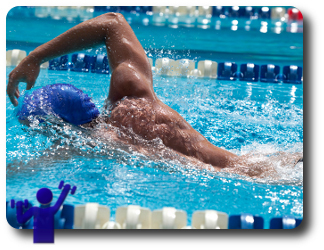 The following is an example of the features of periodization that may encompass a typical 14-week swimming preparation fora national championships or major international meet.
The following is an example of the features of periodization that may encompass a typical 14-week swimming preparation fora national championships or major international meet.
Macrocycle 1: aerobic (weeks 1-4)
As in most training programs the initial phase involves the development or reestablishment of endurance fitness. This serves as the basis for the subsequent development of aerobic and anaerobic capacities and the functional utilization of these capacities. Functional utilization refers to increased swimming speed at a given metabolic load. Apart from the underlying physiological adaptations, improved endurance will lead to an increased ability to cope with fatigue and more rapid recovery from the stresses of speed training and competition. In particular, the aim is to develop the capacity and efficiency of the cardiorespiratory system.
This process is largely achieved by high volumelow intensity training. Other adaptations include increased utilization of fat as a fuel source, stronger ligaments, tendons and connective tissue, adaptations within slow-twitch muscle fibers, and improved neuromuscular control. The length of this phase will depend on several factors (e.g., fitness level of athletes, time available, objectives of mesocycle) but is normally between 3-4 weeks.
Macrocycle 2: aerobic/anaerobic (weeks 5-8)
In this macrocycle, the other primary components of aerobic training are developed. Assuming that low to moderate intensity endurance work is developed in the first microcycle, this cycle is characterized by an emphasis on lactate threshold training.
For example, the 200 m swimmers undertake up to 30% of work in this cycle at the level of lactate threshold, and up to 15% of maximal oxygen uptake and lactate tolerance work. Some coaches may think these levels are too low for middle-distance and sprint athletes (the levels will vary for different sports and events). The total training volume is increased over macrocycle 1 and there is a progressive introduction of shorter and faster intervals. The duration of the macrocycle is normally 2-3 weeks.
Macrocycle 3: transition (weeks 9-12)
In many ways this is the key training phase. The aim is to develop the functional utilization of the energy systems and capacities that were established in the aerobic endurance and aerobic/anaerobic macrocycles. lt is well documented that the factor that correlates most highly with endurance performance is the speed at lactate threshold. This is an important point that is often overlooked.
To illustrate this point consider the following example: Swimmer Ais likely to perform better if his or her speed is faster than swimmer B at the same relative lactate threshold. Improving the functional utilization (speed at a given metabolic load) is achieved through training drills of higher intensity but shorter duration, at speeds close to and faster than competitive speeds.
The high degree of aerobic fitness developed earlier will be maintained even though the emphasis of training is on higher quality intervals. This macrocycle is fairly short with an average length of 3-4 weeks.
Macrocycle 4: taper and competition (weeks 12-14)
The final macrocycle within the season (mesocycle) involves the taper period and the competition phase. Again the logic follows the preceding macrocycle and training is characterized by a further reduction in training volume, and the development of speed and power
In swimming, it is common to reduce the training volume by approximately half (50%) to two thirds (67%) of the peak weekly volume for the preparation. The key is to reduce the volume and sharpen the speed. This process involves shorter intervals at faster than race pace, e.g., for 100-m swimmers there would be an emphasis on 25 and 50-m intervals at faster than 100 m race pace.
It is important to maintain some aerobic training in this macrocycle and a common mistake is to reduce training mileage too rapidly. Aerobic work is needed to support the taper and forms an essential part of the recovery and regeneration process prior to competition.
